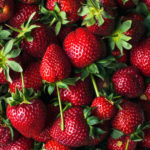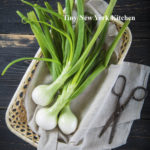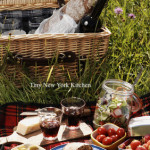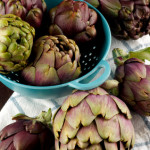Though they are available year-round in grocery stores the best strawberries are to be found in farmer’s markets in spring and early summer.
Look for smaller berries, preferably organic ones, with a rich, glossy red color and shiny green leaves. Avoid berries with white or green shoulders and brown or limp leaves. Never buy them if they are moist, overly soft or show signs of mold. Do not buy berries if their cartons are leaking and wet, a sure sign that unseen fruits will be moldy.
Although fresh strawberries should be rinsed, do not soak them for any length of time since they will absorb the water and turns mushy. For eating on their own, strawberries, even very large ones, should be left whole. Hull strawberries before freezing them or using them for most preparations. Use a small paring knife or a strawberry huller to carve out the white center core from the stem end of each berry. To improve the flavor of lackluster strawberries, hull and slice them, place in a bowl and sprinkle with a tablespoon or two of sugar for every pint. Let stand at room temperature for at least 15 minutes. The sugar draws moisture from the berries to make a sweet natural syrup.
Fresh strawberries are fragile so handle them with care. Don’t wash the berries until just before you are ready to eat them, as the moisture will encourage mold. To store strawberries, line a glass or plastic container with paper towels, carefully arrange the berries inside and cover with the lid. They will keep in the refrigerator for up to 1 week.
©Tiny New York Kitchen © 2021 All Rights Reserved
One of the wonderful things about spring is access to spring onions. Spring onions are typically planted at the end of summer so that they grow over the winter months, ready for harvesting in the spring.
Spring onions are more mature than both scallions and green onions, but are still a type of young onion, which are picked before they have a chance to grow larger. You can identify a spring onion by the small, round, white bulb at its base. While it appears similar to scallions and green onions, its rounded bulb gives it way.
Spring onions are also slightly stronger in flavor than scallions and green onions due to their maturity. They still have a gentler flavor than regular onions, which have been left in the ground much longer and grow much larger.
To prepare spring onions wash them under running water to free them of any dirt and grit. Trim the root end, but only the very, very end. Every last bit of white packs a lot of flavor. If you’re braising or grilling them whole just trim off the top most inch of the greens and you’re done.
If you are using spring onions where you would use scallions the prep is nearly the same. Slice them thinly crosswise for adding to a salad or a vinaigrette. If you’re using them in a stir-fry, cut them on the bias.
©Tiny New York Kitchen © 2021 All Rights Reserved
Pesto is one of those spectacularly simple sauces that only takes minutes to make. Essentially, you just have to throw basil, oil, and garlic into a food processor and you have a fresh pesto.
The wonderful thing about pesto is that it can be used for more than a plate of pasta. You can bake it on chicken, mix it into soup, add it to bruschetta, mix it in a skillet with eggs and hash browns, add it to a grilled chicken sandwich, or add it to a quesadilla. You can also add a dollop of mayonnaise to a few tablespoons of pesto to create a quick and easy aioli to use on sandwiches.
Pesto is excellent for transforming leftovers into something quick and delightful. You can take the pesto aioli and pair it with a leftover chicken cutlet, tomato slices, and a crusty slice of baguette to create a delicious sandwich.
“Work With What You Got!”
©Tiny New York Kitchen © 2020 All Rights Reserved
The word picnic was originally a 17th Century French word, picque-nique. Its meaning was similar to today’s meaning: a social gathering where each attendee brings a share of the food.
Going on a picnic sounds like a great idea, but it might feel a bit daunting if you haven’t been on one in a long time. Deciding what to eat, where to go and what supplies to take can seem like a big confusing task. Take away any picnic apprehension with some easy pre-planning and a supply checklist and you’ll be headed out for a great day in the sun with family and friends!
Get started with where you would like to go and find out what amenities are available at your chosen location. Are there pavilions with shade and picnic tables? Is there running water? Are grills permitted or available? Do you need to make a reservation? Once you have these core questions answered you’ll be able to plan your menu and supply list.
Supply Check List:
**Blanket, Chairs, Games, Music
**Tablecloth, Paper Towels, Wipes, Hand Sanitizer, Bug Spray, Sunscreen, Trash Bags, First Aid Kit
**Plastic Ware, Plates, Cups, 1 Sharp Knife, Plastic Bags Or Containers For Leftovers
**Cooler Bags Or Large Cooler With Wheels, Ice Packs, Bagged Ice Cubes For Drinks, Bottled Water
Depending on if you will be grilling or need to bring pre-prepared food, you can come up with countless menu options. Sandwiches and cold salads make for great picnic fare, or if grilling is an option, pre-marinated meals and vegetables, hot dogs, and corn on the cob are always delicious prepared outdoors. Remember to pack raw foods separately and keep them in the cooler until ready to cook.
“Work With What You Got!”
©Tiny New York Kitchen © 2019 All Rights Reserved
Scones are made in one bowl and are practically foolproof, so they’re great for beginners. Use parchment paper to line baking sheets for easy cleanup.
“Work With What You Got!”
©Tiny New York Kitchen © 2019 All Rights Reserved
Juicy berries are bursting with flavor and now is the perfect time to pick them up, whether for snacking or adding to sweet and savory recipes.
Make sure to look for bright, shiny strawberries, and skip any that are smashed, shriveled, or moldy. Their color should be deep and even, with no white or green patches, and they should smell fragrant.
Wait to wash them. Water increases the risk of mold, so leave berries in their original packaging and rinse in cold running water just before serving. Their shelf life is short, so serve or cook berries within 2 to 3 days.
Despite their sweetness, strawberries are relatively low in sugar. They also provide fiber, antioxidants, and vitamin C. In fact, strawberries contain more vitamin C per serving than oranges!
“Work With What You Got!”
©Tiny New York Kitchen © 2019 All Rights Reserved
If vegetables could speak, asparagus would surely say “spring.” While it’s available all year, nothing compares to the fresh spears that appear each spring. Asparagus is one of the first crops of the season, and after a long winter, when green produce is sparse, seeing the tips peek out of the soil is a welcome sight. A short shelf life means it’s best to seek out local asparagus. Look for glossy spears, tightly closed tips, and freshly cut ends.
While green is the most common asparagus, you can often find purple and white spears in stores.
Purple asparagus is grown the same way as green and is also green on the inside. These spears usually taste a bit sweeter and nuttier and are tasty raw.
White asparagus is grown without sunlight, so it doesn’t produce chlorophyll, which keeps it colorless, or white. The stalks should be peeled before cooking. It’s milder in flavor and less grassy than green and best served blanched.
“Work With What You Got!”
©Tiny New York Kitchen © 2019 All Rights Reserved
An ancient symbol of fertility, artichokes are fitting for spring, when we celebrate renewal. Find them year-round – fresh, frozen, canned, and jarred. Artichokes are at their best from March to June.
To Trim Artichokes
Pick off the tough outer leaves until you reach paler, more tender leaves.
With a chef’s knife, cut off the top one-third of the artichoke and all but an inch of the stem.
With a paring knife, cut off the tough green skin on the stem and any tough leaves near the base.
Cut the artichoke in half lengthwise.
With a melon baller or small spoon, scoop out and discard the “choke,” the spiky interior near the stem.
While trimming, keep artichokes in a bowl of water with lots of lemon juice so they don’t turn brown.
“Work With What You Got!”
©Tiny New York Kitchen © 2019 All Rights Reserved
Add this Cucumber Cabbage Salad to your Easter or Passover menu. Fresh dill adds bright spring flavor to this crunchy salad.
It is truly a sign of spring when Fiddleheads appear. Fiddleheads (Ostrich Fern) have a striking appearance, which looks like the neck of a fiddle and tastes somewhere between green beans and asparagus.
Fiddleheads are best served simply. Sauté with a bit of butter and an allium, such as garlic, shallots, or minced onion.
When purchasing fiddleheads, look for fresh bright green, tightly coiled plants. If you see browning that is a sign of age. You’ll want to avoid the browned ones.
To prepare for cooking, wash about 1 1/4 pounds of fiddleheads in cold water and rub away any papery “scales,” then trim the ends. Because the plants are wild, it is wise to make sure they are thoroughly cooked before serving, to avoid the possibility of a food borne illness. The best method is to boil them in salted water for about 10 minutes and then sauté them.
“Work With What You Got!”
©Tiny New York Kitchen © 2019 All Rights Reserved















